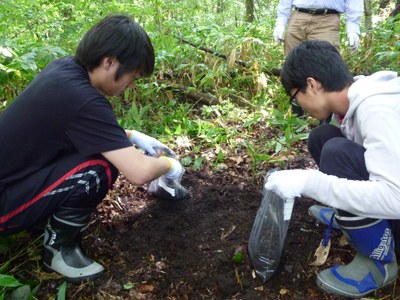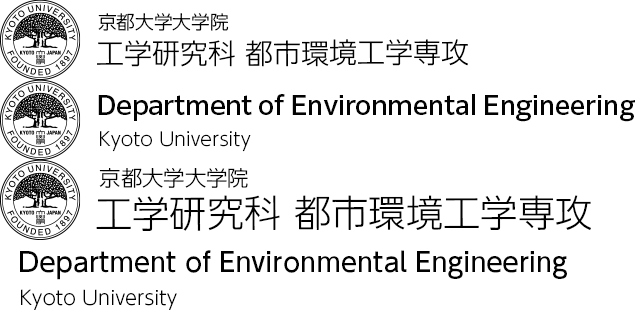Environmental Risk Analysis
With the progress of science and technology, various substances such as artificial chemicals, heavy metals, radioactive substances, etc. are discharged into the environment, causing long-term and widespread environmental pollution, and environmental risks (adverse effects on human health, life, economic / social system, ecosystem). In order to take measures to reduce environmental risks, it is necessary to quantitatively grasp how and how much adverse effects are caused by various harmful substances.
In our laboratory, we evaluate environmental risks by analyzing the dynamics of the environmental pollution caused by various harmful chemicals locally and globally released, the exposure pathways to humans, and the human health risks using monitoring, experimental study and numerical simulations. Furthermore, we are trying to clarify what measures are effective in reducing environmental risks with both engineering and social science approach.
Academic Staff
Minoru YONEDA
 Professor (Graduate School of Engineering)
Professor (Graduate School of Engineering)
Research Topics
Researches on the dynamics and exposure assessment of various hazardous substances including radioactive materials in the general living environment, and on the evaluation of the risks to the general public from these substances. Researches on dose reduction methods in forests contaminated with radiocesium, and on methods for measuring the composition of aerosol are also conducted.
Contacts
Room 466 (C1-3), C-cluster, Katsura Campus
TEL: +81-75-383-3355
FAX: +81-75-383-3358
E-mail: yoneda![]() risk.env.kyoto-u.ac.jp
risk.env.kyoto-u.ac.jp
Yoko SHIMADA
 Associate Professor (Graduate School of Engineering)
Associate Professor (Graduate School of Engineering)
Research Topics
Our health is threatened by various types of environmental risks such as radioactive substances and hazardous materials. My goal is to understand how much our daily lives influence environment and what kind of measure is effective for mitigating such risks through modeling. In order to solve both global and local environmental problems, I provide information and help government's decision making process.
Contacts
Room 464 Bidg. C1-3, C cluster, Katsura Campus
TEL: +81-75-383-3357
FAX: +81-75-383-3358
E-mail: shimada![]() risk.env.kyoto-u.ac.jp
risk.env.kyoto-u.ac.jp
Ryota GOMI
Assistant Professor (Graduate School of Engineering)
Research Topics
- Genomic analysis of antibiotic resistant bacteria in the environment
- Microbial source tracking of Escherichia coli in environmental waters
Contacts
Room 466 (C1-3), C-cluster, Katsura Campus
TEL: +81-75-383-3354
FAX: +81-75-383-3358
E-mail: gomi risk.env.kyoto-u.ac.jp
risk.env.kyoto-u.ac.jp
Research Topics
Risk assessment and countermeasures for radioactive materials released by the Fukushima Daiichi Nuclear Power Station accident
Radioactive materials released by the Fukushima Daiichi Nuclear Power Station accident on March 11, 2011 have diffused into the environment and polluted the soil and forests of the affected areas, and there are still areas where residents have not been able to return. We are conducting research on the following themes regarding the environmental dynamics of radioactive materials in contaminated areas, radiation exposure assessment of residents, and future decontamination of forests.
- Comprehensive health risk assessment considering the lifestyles of residents in the areas affected areas
As for returning to the area affected by the Fukushima Daiichi Nuclear Power Plant accident, many people hesitate to return because the exposure dose is higher than the public exposure dose limit of 1 mSv / year. Therefore the lifetime exposure should be quantified in consideration of the diversity of residents' lifestyles. In addition, evacuation and living behavior to avoid radiation exposure have health effects such as lifestyle-related diseases and stress. In this study, we are aiming to develop an exposure dose evaluation method that takes into consideration the diversity of inhabitants classified by gender, age, etc. and the differences in lifestyle such as living time and housing style.
- Development of dynamic analysis of radioactive materials in forest areas and optimal forest decontamination evaluation method
In order to swiftly promote environmental restoration and reconstruction in areas contaminated with radioactive substances, it is necessary to reduce the air dose by decontaminating forests. In this study, we analyze the dynamics of radioactive substances in forest soil and forest ecosystems, and develop a model that can quantitatively calculate the air dose from forests and the reduction in air dose rate due to decontamination of forests on flat land surrounded by forests. We are aiming to propose the optimum decontamination evaluation method for forests by conducting simulations.

Fig1. Forest soil sampling

Fig2. Caludurated results of underground distribution of Cs-137 10 years after decontamination level
Risk assessment of various environmental pollution
In assessing the risk of environmental pollution caused by a wide variety of trace environmental pollutants, it is important to quantitatively grasp the relationship between human activities and environmental pollution. In our laboratory, we are working on risk assessment by analyzing the emission sources of environmental pollutants in consideration of lifestyle and socio-economic activities. We are also trying to analyze pollution phenomena that could not be grasped by conventional methods and the existence form and pollution of new pollutants using new research approaches such as analysis methods at the genetic level.
- Genomic analysis of antibiotic resistant bacteria in the environment
The occurrence of antibiotic-resistant bacteria (ARB) in the environment is of great concern. However, unlike clinical ARB, genetic characteristics of environmental ARB are not well understood. Using genomic analysis, we are studying ARB, especially antibiotic-resistant Enterobacterales, in the environment.
- Microbial source tracking of Escherichia coli in environmental waters
Escherichia coli has been used as an indicator of fecal pollution in environmental waters. However, little success has been achieved in tracking the sources of E. coli in environmental waters. In our laboratory, we try to develop microbial source tracking markers targeting E. coli that can be used for identifying the sources of E. coli (and fecal pollution) in environmental waters.

Fig3. Developing a model of environmental pollution risk

Fig4. Phylogenetic analysis of antibiotic-resistant Escherichia coli
Laboratory Website
http://risk.env.kyoto-u.ac.jp/
